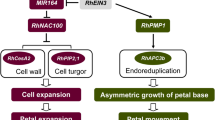Abstract
Normal and pollination-induced senescence of Petunia hybrida L cv. Pink Cascade flowers is accompanied by an increase in the sensitivity of the corolla to ethylene as indicated by an acceleration in the rate of corolla bluing after exposure to exogenous ethylene. Pollination resulted in the production of short-chain saturated fatty acids ranging in chain length from C6 to C10. Following pollination, these acids are synthesized in the stylar tissue via the acetate pathway within the first 12 hours. The fatty acids are transported rapidly to the corolla where they induce an increase in ethylene sensitivity. In unpollinated flowers, these acids are produced in the corolla during the early stages of senescence. Although the levels of these fatty acids decrease rapidly during the final stages of senescence, a significant increase in ethylene sensitivity could be detected prior to the decrease. It appears that the increase in ethylene sensitivity caused by the synthesis of short-chain saturated fatty acids occurs concurrently, but independent from ethylene synthesis.
Similar content being viewed by others
References
Brady CJ (1987) Fruit ripening. Ann Rev Plant Physiol 38:155–178
Enteman C (1957) General procedure for separating lipid components of tissue. Meth Enzymol 3:299–317
Gilissen LJW and Hoekstra FA (1984) Pollination-induced corolla wilting in Petunia hybrida rapid transfer through the style of a wilting-inducing substance. Plant Physiol 75:496–498
Halevy AH and Mayak S (1981) Senescence and postharvest physiology of cut flowers. Part 2. Hortic Rev 3:59–143
Halevy AH and Whitehead CS (1989) Pollination-induced corolla abscission and senescence and the role of short-chain faty acids in the process. In: DOsborne and MJackson, eds. Signals in Cell Separation. Proc NATO Symp Berlin: Springer Verlag (in press)
Halevy AH, Whitehead CS and Kofranek AM (1984) Does pollination induce corolla abscission of cyclamen flowers by promoting ethylene production? Plant Physiol 75:1090–1093
Hoekstra FA and Weges R (1986) Lack of control by early pistillate ethylene of the accelerated wilting of Petunia hybrida flowers. Plant Physiol 80:403–408
Lovell PJ, Lovell PH and Nichols R (1987) The importance of the stigma in flower senescence in petunia (Petunia hybrida). Ann Bot 60:41–47
Lovell PJ, Lovell PH and Nichols R (1987) The control of flower senescence in petunia (Petunia hybrida). Ann Bot 60:49–59
Maxie EC, Farnham DS, Mitchell FG, Sommer NF, Parsons RA, Snyder RG and Rae HL (1973) Temperature and ethylene effects on cut flowers of carnation (Dianthus caryophyllus L.). J Amer Soc Hortic Sci 98:568–572
Morgan PW and Hall WC (1964) Accelerated release of ethylene by cotton following application of indolyl-3-acetic acid. Nature 201:99
Nichols R (1966) Ethylene production during senescence of flowers. J Hortic Sci 41:279–290
Nichols R (1971) Induction of flower senescence and gynoecioum development in carnation (Dianthus caryophyllus) by ethylene and 2-chloroethyl-phosphonic acid. J Hortic Sci 46:323–332
Nichols R, Buffler G, Mor Y, Fujino DW and Reid MS (1983) Changes in ethylene production and 1-aminocyclopropane-1-carboxylic acid content of pollinated carnation flowers. J Plant Growth Regul 2:1–8
Nichols R and Frost CE (1985) Wound-induced production of 1-aminocyclopropane-1-carboxylic acid and accelerated senescence of Petunia corollas. Scientia Hortic 26:47–55
Radin NS (1969) Preparation of lipid extracts. Meth Enzymol 14:245–254
Reid MS, Fugino DW, Hoffman NE and Whitehead CS (1984) 1-aminocyclopropane-1-carboxylic acid (ACC) — The transmitted stimulus in pollinated flowers? J Plant Growth Regul 3:189–196
Sagee O, Goren R and Riov J (1980) Abscission of citrus explants: Interrelationships of ABA, ethylene and hydrolytic enzymes. Plant Physiol 66:750–753
Trewavas AJ (1981) How do plant growth substances work? Plant Cell Environ 4:203–228
Trewavas AJ (1982) Growth substance sensitivity: The limiting factor in plant development. Physiol Plant 55:60–72
Veen H (1979) Effects of silver on ethylene synthesis and action in cut carnations. Planta 145:467–470
Went FW and Thimann KV (1937) Phytohormones. New York: Macmillan
Whitehead CS and Halevy AH (1989) The role of octanoic and decanoic acid in ethylene sensitivity during pollination-induced senescence of Petunia hybrida flowers. Acta Hortic (in press)
Whitehead CS, Halevy AH and Reid MS (1984) Roles of ethylene and 1-aminocyclopropane-1-carboxylic acid in pollination and wound-induced senescence of Petunia hybrida flowers. Physiol Plant 61:643–648
Yang SF and Hoffman NE (1984) Ethylene biosynthsis and its regulation in higher plants. Ann Rev Plant Physiol 35:155–189
Author information
Authors and Affiliations
Rights and permissions
About this article
Cite this article
Whitehead, C.S., Halevy, A.H. Ethylene sensitivity: The role of short-chain saturated fatty acids in pollination-induced senescence of Petunia hybrida flowers. Plant Growth Regul 8, 41–54 (1989). https://doi.org/10.1007/BF00040915
Issue Date:
DOI: https://doi.org/10.1007/BF00040915




